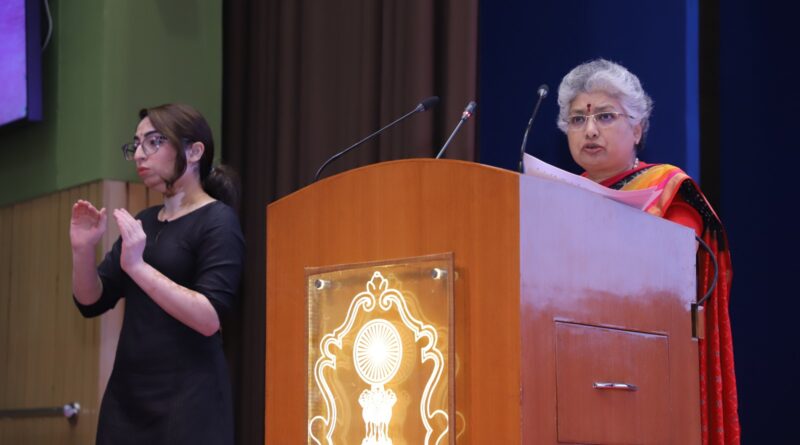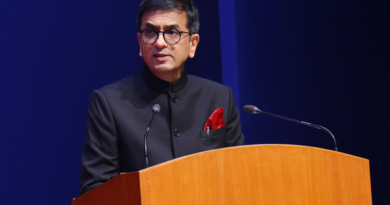Judiciary Must Heal, Not Harm: Justice BV Nagarathna Advocates Sensitive Handling of Child Abuse Cases
(By Syed Ali Taher Abedi)
New Delhi, Oct 11 — Justice B.V. Nagarathna of the Supreme Court of India has called for the urgent institutionalization of trauma-informed and child-sensitive procedures within the judiciary and law enforcement agencies to ensure that victims of violence—particularly girl children—are not subjected to re-traumatization or secondary victimization during legal inquiries and proceedings.
Delivering the opening address at the Tenth Round of the National Annual Stakeholders’ Consultation on Safeguarding the Girl Child, Justice Nagarathna emphasized that the judiciary and police play a pivotal role in shaping a protective and empathetic legal ecosystem for child victims. She urged that courts and police stations must evolve into safe spaces, where the dignity and psychological well-being of the girl child are preserved throughout the justice delivery process.
“A young girl in India can be said to be a truly equal citizen only when she can freely aspire to do anything that her male counterpart does and receive the same quality of support and resources to do so, facing no barriers specific to her because of her gender. Put differently, the odds of her being born at all, having access to the right nutrition, care, education and material resources, a secure and safe environment, developing a distinct sense of self and being able to achieve whatever she sets her mind to has to be equivalent to that of a boy child born in this country. She should not merely survive but actively thrive.”
“The girl child must be treated as a truly equal citizen under the Constitution,” she asserted, invoking the spirit of Articles 14, 15(3), and 21, which enshrine the principles of equality, protection, and dignity for all children, especially those from vulnerable backgrounds.
Justice Nagarathna highlighted the intersectional vulnerabilities faced by girl children, particularly those from marginalized castes, economically weaker sections, or those living with disabilities. She noted that these compounded disadvantages often result in systemic neglect and heightened exposure to exploitation, including child marriage, trafficking, and sexual violence.
“The next issue is that of child marriage in India. In this regard, it is extremely commendable that as per successive National Family Health Surveys (NFHS) show, the prevalence of child marriage has steadily declined: from 47 per cent in NFHS-3 (2005– 06), to 27 per cent in NFHS-4 (2015–16) and further down to 23 per cent in NFHS-5 (2019–21). Thus, over the course of the last fifteen years, a combination of policy efforts and community engagement have led to an almost halving of the rate of child marriage in India.
Through the enactment of laws such as the Prohibition of Child Marriage Act, 2006 and in accordance with India’s international obligations under the UN Convention on the Rights of the Child, both State and Union Governments, occasionally in collaboration with UNICEF have undertaken several positive steps.
The need of the hour is to adopt holistic solutions that are adequately tailored to regional peculiarities, so as to ensure that interventions undertaken are most effective.”
Citing data from the 2011 Census and the National Family Health Survey-5 (NFHS-5), she drew attention to the nutritional deprivation faced by adolescent girls. The NFHS-5 revealed that 59% of girls aged 15–19 was anaemic, a statistic she described as “deeply troubling.” Justice Nagarathna attributed this to deliberate underfeeding and gender-based neglect in households, despite the existence of government schemes like Anemia Mukt Bharat and Poshan Abhiyan, which have improved access to nutrition but require stronger implementation and monitoring.
“Next, access to quality nutrition as a critical facet to the girl child’s growth and development is important. Without adequate nourishment, all other measures undertaken to uplift the girl child may be at naught. Malnutrition, especially in the early years of a girl child’s life, may go on to determine her health and quality of life for many decades. According to the National Family Health Survey-5, 36% of surveyed children were stunted or short for their age, 19% are wasted or thin for their height, 32% are underweight and 3% are overweight. A whopping 59% of girls aged 15 – 19 were found to be anaemic.”
On the issue of child marriage, she called for robust enforcement of the Prohibition of Child Marriage Act, 2006, stating that legal deterrence must be matched with community-level awareness and vigilance. She also underscored the role of education as a cornerstone for both empowerment and national prosperity, urging stakeholders to prioritize universal access to quality schooling for girls.
Justice Nagarathna stressed the need for enhanced oversight of child protection laws, particularly the Juvenile Justice (Care and Protection of Children) Act and the Protection of Children from Sexual Offences (POCSO) Act, to ensure that statutory safeguards translate into real-world protection.
In her concluding remarks, she acknowledged the milestones achieved over the past decade, including the expansion of Juvenile Justice Boards, Child Welfare Committees, and District Child Protection Units. However, she cautioned that progress must not breed complacency, and called for continuous evaluation, training, and sensitization of all stakeholders involved in child welfare and justice.
Justice Nagarathna’s address served as a powerful reminder that legal reform must be accompanied by cultural transformation, and that the Constitutional promise of equality and protection for the girl child must be fulfilled not just in letter, but in spirit.



